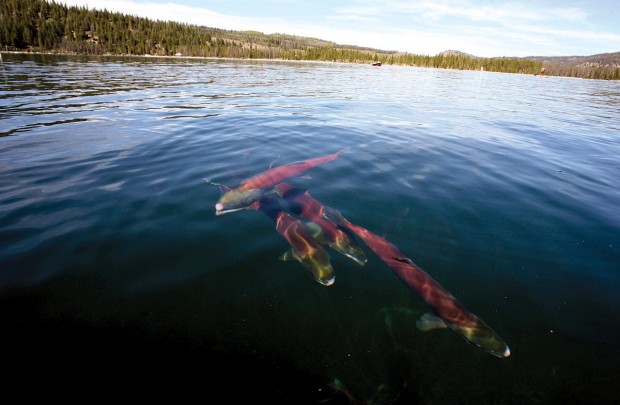forum
library
tutorial
contact

Mother Nature Serves Up
Sockeye Surprise
by Bill Rudolph
NW Fishletter, July 24, 2014
|
the film forum library tutorial contact |

|
Mother Nature Serves Up
by Bill Rudolph
|
 This year's amazing sockeye run got its second wind July 4, when more than 34,000 fish were counted at Bonneville Dam, and another 100,000 showed up over the next few days. The second wave made harvest managers rethink their earlier upgrade (425,000 to river mouth) and boost it to 560,000 on July 7. Their preseason estimate was 347,000 fish.
This year's amazing sockeye run got its second wind July 4, when more than 34,000 fish were counted at Bonneville Dam, and another 100,000 showed up over the next few days. The second wave made harvest managers rethink their earlier upgrade (425,000 to river mouth) and boost it to 560,000 on July 7. Their preseason estimate was 347,000 fish.
By July 9, the Bonneville count was more than 539,000 sockeye, clearly a new record, surpassing the previous high of 516,000 in 2012. Most are headed for British Columbia's Lake Osoyoos, where juvenile survival has improved significantly, thanks to late summer water releases to keep juvenile fish cool. The young sockeye spend a year overwintering in the lake after hatching, before they migrate down the Okanogan and Columbia rivers, past nine dams, to the ocean.
Ten days later, the sockeye count topped 600,000. A few days before that, harvest managers came up with a new estimate of 600,000 to the river mouth. More than 1,000 a day are still passing the dam. By July 23, the Bonneville count was nearly 609,000. On July 21, they raised their run-size estimate to 615,000.
It could be a banner year for Lake Wenatchee sockeye, as well. About 64,000 (to Columbia mouth) were expected preseason, but it will take a while to sort out the numbers.
More than 4 million sockeye smolts were estimated to have left Lake Osoyoos in 2012, reported Canada Department of Fisheries and Oceans scientist Kim Hyatt, head of the agency's Salmon in Regional Ecosystems Program, at the Pacific Biological Station in Nanaimo, B.C. He said 4.1 million Osoyoos wild-origin fish plus another 277,000 Skaha hatchery-origin smolts went seaward in spring 2012.
A 2014 peer-reviewed paper (Williams et al.) that studied recent sockeye returns found that the large 2010 return from the 2008 outmigration "occurred because of high survival from juvenile to adult, whereas the high adult return in 2012 occurred because of a huge number of juveniles; survival from juvenile to adult was only one-third of the 2008 outmigration."
The paper had estimated the 2008 smolt-to-adult return rate for sockeye from McNary Dam back to Bonneville at more than 23 percent; the 2010 return rate was pegged at 6.2 percent.
It is generally thought that only about half the juveniles that leave Lake Osoyoos survive to McNary Dam. It's no picnic for adults, either. Only about half of the adults survive the last part of their migration from Wells Dam, up the Okanogan River, to the B.C. lake.
So this year's return rate could be right up there with the 2008 SAR, which points to excellent ocean conditions for the 2012 sockeye outmigration. In fact, the sockeye paper found "the strength of the April upwelling had a high association with sockeye SARs."
Next year could be even bigger. Jeff Fryer, a biologist with the Columbia River Inter-Tribal Fish Commission, said adult monitoring at Bonneville Dam has estimated that about 10 percent of the 2014 sockeye return is made up of jacks, more than 50,000 at this point. He noted that last year's excellent jack count was in the 30,000-fish range.
The Snake River sockeye run is also doing very well, with 2,196 counted at Lower Granite Dam by July 23. That is more than three times the 10-year average for the ESA-listed stock that an expensive captive broodstock program has brought back from the brink. It looks like this year's return will beat the 2010 return of 2,201 Snake River sockeye, a record run since the captive broodstock program began in the 1990s.
Some other sockeye runs in the region are expected to do well, especially B.C.'s Fraser, where 23 million are expected. But this year's Lake Washington run is running far behind expectations. Fewer than 47,000 had been counted by July 20. The preseason forecast was for a 167,000-fish return. Nearly 134,000 returned last year. The sockeye return to Baker Lake is also running behind expectations, though numbers have been picking up in recent days. About 10,000 have returned, so far; about 35,000 were expected.
learn more on topics covered in the film
see the video
read the script
learn the songs
discussion forum
